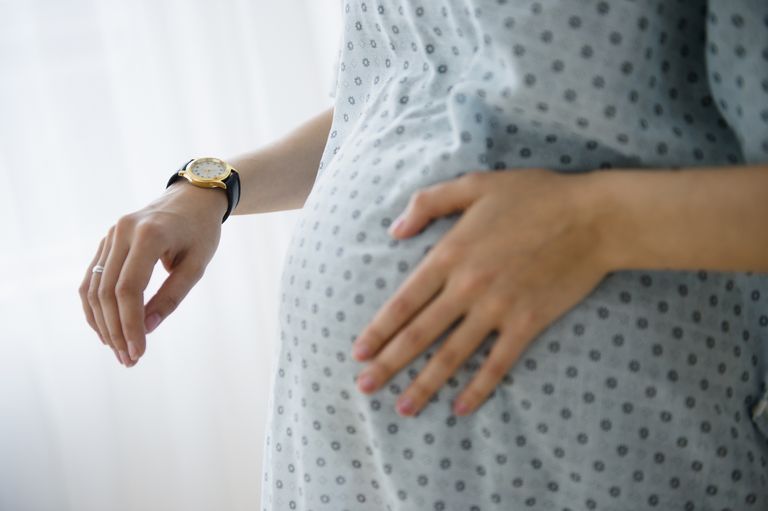
Guys, there is so much to look forward to about pregnancy and birth: the adorable socks, that thing babies do when they grab your finger, and, you know finally getting that other living thing out of your stomach.
But wait…that requires actually pushing something the size of a watermelon out of your vagina (*cringe*). How the heck is that supposed to happen, you ask? Contractions. Here’s the lowdown on those ever-so-helpful (but ultimately painful) baby-pusher-outers.
I need a refresher: What are contractions?
“A contraction is just a squeezing of a muscle,” says John Thoppil, M.D., an ob-gyn at River Place OB/GYN and an assistant professor at Texas A&M University’s College of Medicine.
When you’re having a baby, that muscle in question is your uterus—and the harder that muscle squeezes, the more it hurts, says Thoppil.
That muscle is squeezing, by the way, because your body has to do a lot of work to dilate your cervix, turn your baby the ideal direction (face down), and send the baby down the birth canal.
Essentially, when a woman is full-term, hormonal changes within the body may signal when she’s ready to begin labor, says Thoppil; but the baby might have a say, too. According to a 2015 study in the journal PLoS One, the baby itself could send signals to the mother through its DNA, signaling it’s ready to be born (though more research is necessary to be sure).
When a woman isn’t full-term, however (less than 37 weeks pregnant) and feels contractions, that could indicate pre-term labor, when something external (like an infection) triggers contractions. In that case, it’s important to call your doctor right away, says Thoppil, adding that you should never ignore early contractions.
But there are different types of contractions, right?
So there are basically two types: Braxton Hicks contractions and labor contractions.
Braxton Hicks contractions—a.k.a. “false labor contractions” or “practice contractions”—happen when your uterus is gearing up for birth, but they don’t help dilate your cervix the way labor contractions do. These contractions can start as early as the second trimester, according to the American Pregnancy Association (APA).
Basically, the muscles in your uterus tighten for about a minute, but it’s not usually painful—your stomach will likely just feel hard. They’ll come at irregular times and aren’t intense—both signs they’re not labor contractions. However, if you have a lot of them, talk to your doctor, says Thoppil.
Since Braxton Hicks contractions are like practice, that means actual labor contractions are end-game. They’re more consistent and regular—you can even start to time them and see a pattern. (Like they’re coming every 10 minutes and lasting for 30 seconds.)
Eventually, they’ll start to come quicker, last longer, and become more intense, and you may even feel pain in your lower back (another significant difference from Braxton Hicks contractions). Thoppil recommends patients go to the hospital once contractions are five to seven minutes apart for an hour and feel increasingly painful.
Luckily, that pain can be controlled—most commonly through an epidural, according to the American College of Obstetrics and Gynecology (ACOG). (An epidural would be a pain medication that’s administered through a tube placed in the lower back, btw.) Epidurals typically make you lose some feeling in the lower areas of your body, though you’re able to stay awake and alert enough to bear down and push the baby out.
Okay, tell me what they really feel like (and be honest).
They’re different for every woman—honest.
Even more honesty: My active labor contractions felt like a meat grinder was taken to my stomach—the pain actually made me throw up. My best friend, however, didn’t feel her contractions at all (she was actually applying makeup at eight centimeters dilated out of ten).
If you want even more specificity: Contractions, for me at least, came in waves. I’d feel the contraction building, my stomach would tighten and my back would radiate with pain, then after hitting a crest, the pain would subside (only to come again, but you take what you can get).
But don’t take my word for it. Here’s how other women described their contractions:
“Very intense menstrual cramps that wrapped around my body like a snake. I could not sit through them. Had to be moving and breathing.” –Reddit user kdrknows
“Mine did not feel like period cramps at all. I felt a tightening in my lower belly and lower back, like someone was tightening a belt around me so tight. They started out mild, but quickly got so painful I couldn’t speak or didn’t want to speak and just had to close my eyes to deal with them.” –Reddit user divinenanny
“Mine felt like period cramps x1000. They would start in my lower back and move forward around my hips to my belly and everything tightened up. They slowly got stronger and stronger.” –Unknown Reddit user
Is there anything else I need to know about contractions?
Well, the pain isn’t over after labor! Contractions continue in part to help push the placenta out (you’ll also likely get a dose of pictocin to help this process along and decrease the risk of bleeding, says Thoppil).
Then, if you choose to breastfeed, you’ll also get contractions during that. “When you breastfeed, your body releases oxytocin, the same hormone that’s produced during contractions,” says Thoppil.
These may feel like hell (again), and anecdotally, many women say that with each subsequent pregnancy they get worse. But there is a bright side: “It’s nature’s way from keeping women from bleeding to death, as the contractions squeeze down the uterus and decrease postpartum bleeding,” says Thoppil.
Also: These breastfeeding contractions are at their worst for 24 hours after birth—then, they start to subside significantly, says Thoppil.
Pregnancy: What a miracle—amirite?
Source: Read Full Article

